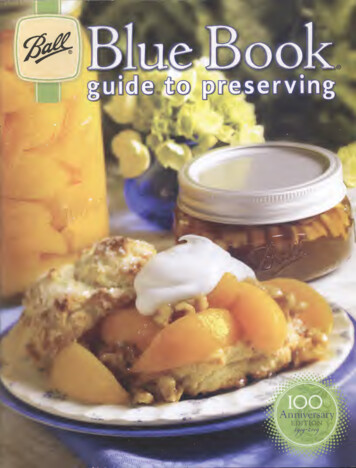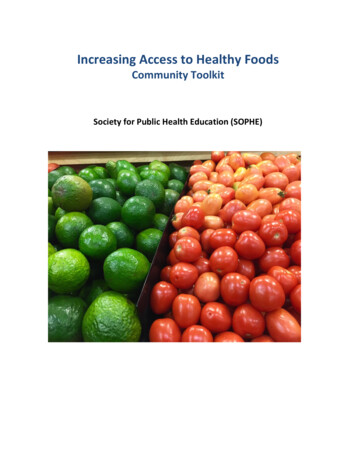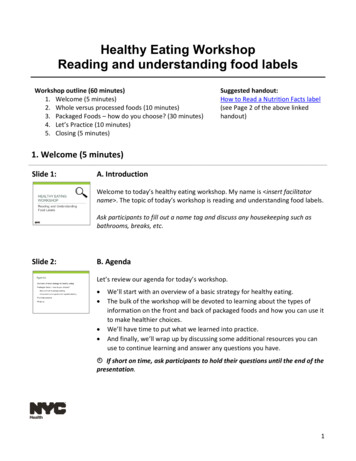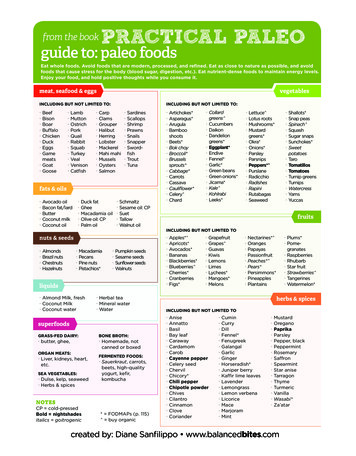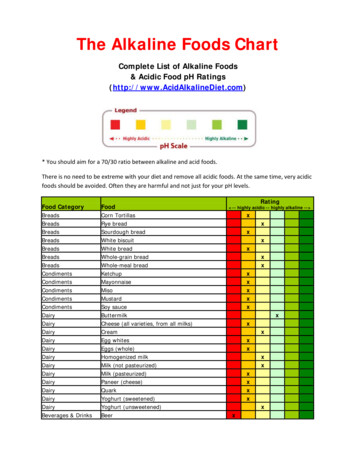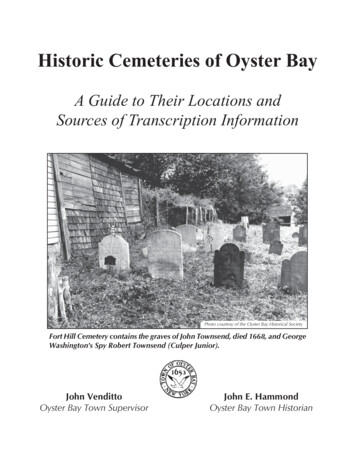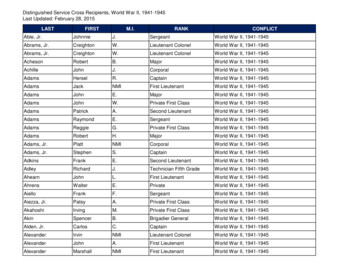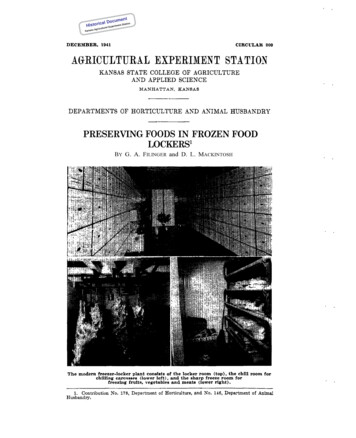
Transcription
tcumencal DoHistoririmentral Expeultuas AgricStationKansPRESERVING FOODS IN FROZEN FOODLOCKERS1BY G. A. FILINGER and D. L. MACKINTOSH
tcumencal DoHistoririmentExpeulturalas AgricStationKansFOREWORDThe use of frozen food lockers by farm and townspeople for storing foods for their own use has increased rapidly in Kansas duringthe last few years. Refrigerated locker plants are located a t presentin almost every section of the state and their number and distribution is still increasing. There are about 200 plants now operating inKansas, making over 50,000 individual lockers available for rent.The frozen food locker plant makes it possible for the family toutilize fresh home-grown meat, poultry, fruit and vegetables throughout the entire year and a t a material saving in cost.The maximum economy in use of the frozen food locker can berealized by those rural families who produce their own products;the urban resident, through careful planning and buying can alsorealize a real saving through the use of frozen food lockers. Becauseof the desire for information relative to the use of this type of preservation on the part of locker patrons, the following suggestions, basedon trade practices and on research work conducted a t the Kansasand other state agricultural experiment stations, are presented inthis circular.The use of frozen food lockers should be as carefully planned asany other farm or home operation. Seldom is money saved by renting a locker to store an occasional surplus of some perishable food.A definite saving in food costs can be shown, however, through thewell-planned, year-round use of a locker.Since the methods of preparing and packing fruits and vegetablesdiffer so much from methods of handling meats, the information ispresented in two parts.The recommended sanitary regulations of the Kansas State Boardof Health and additional suggestions for cutting and packing meatare appended—G. A. F., D. L. M.
tcumencal VING FRUITS AND VEGETABLESIN FROZEN FOOD LOCKERSBy G. A. FILINGERThe preservation of fruits and vegetables by the quick freezingprocess, if properly done, preserves the flavor, the color and the vitamins better than any other method. The use of frozen products hasincreased rapidly during the last few years and commercial firmshave kept pace with this demand by annually increasing their production of frozen fruits and vegetables. The use of communityfreezer lockers by farmers and townspeople has likewise increased.Many problems in connection with preservation of foods by freezingare still unsolved but sufficient progress has been made to assuregood products of many kinds if a few simple directions are followed.FruitsThere are five general methods of packing fruits for freezing:1. Packed whole without sweetening.—A few fruits, such asstrawberries, raspberries, cherries and blackberries, may be frozenwhole without any treatment except sorting and washing. Theymust be kept a t low temperatures and well sealed to prevent thefruit from drying. This method is not as desirable as those requiring the addition of sugar or syrup.2. Packed whole with sugar.—This is the oldest and mostcommonly used method in freezing small fruits. This method isespecially desirable if the fruits are to be used in baking. The fruitis sorted, washed, and packed with sugar. A common proportion isthree parts of berries to one part of sugar. Some prefer less sugarand mix the fruit four or five to one. The berries and sugar shouldbe allowed to stand for an hour or two to dissolve some of the sugarin the fruit juice before freezing. There is no advantage in addingsugar to dry fruits like gooseberries.3. Packed whole with syrup.—If small fruits are to be used fordesserts and thawed before use, they may be covered with a 40 to 50percent syrup (See Table 1). The syrup dilutes the fruit flavorsomewhat, but preserves the shape of the fruit and penetrates thefruit during storage.4. Sliced and packed with syrup.—Large fruits, such aspeaches, apricots, and plums are sliced, covered with a cold 40- to50-percent syrup, and held for some time in a cool room to allowthe syrup to penetrate the tissues of the fruit before freeezing.5. Sliced or crushed and packed with sugar.—Juice fruits,such as strawberries, may be crushed or sliced and mixed with sugarbefore packing into containers for freezing. Since no water is added,the flavor is unimpaired. This method is recommended for fruitsof irregular size and shape.
tcumencal DoHistoriKansasrimentral ExpericultuStationAgFruit juices and fruit pulps are excellent if preserved by freezing.They should be stored in air-tight containers. Glass containerswhich are narrower a t the top than a t the bottom may crack if usedfor fruit juice containers. Allow 1 to 1½ inches for expansion ofthe juices. (Fig. 2.)Table 1 may be used in determining the amount of sugar and waterto use in making up syrups. The proportions of sugar and waterare based on weights, but volume measurements are sufficiently accurate. A pint of water weighs about a pound for this purpose anda slightly rounded pint measure of sugar, well settled, also weighsapproximately a pound.The amount of syrup necessary to pack a quart of fruit will varywith the size of the fruits or fruit pieces and with the tightness ofthe pack but usually from 1 to 1½ cups will be required.Containers.- Containers for frozen fruits and vegetables shouldbe reasonably air tight, moisture proof, strong, of a shape that iseconomical of space in the locker and allows removal of productseasily, and economical in cost. A large number of containers arenow on the market and many of them meet these requirements.Glass Containers, such as the common fruit jars, may be used ifthey do not have a too decided shoulder and if they are not filled upinto the tapered portion when a liquid is added. Wide-mouthed jarsare preferred.Heavily paraffined or waxed cartons, either cylindrical or tubshaped, are satisfactory if the lids are practically air tight.Square or rectangular cartons are more economical of space in thelockers but where cellophane linings are used inside of the cartons,the lining may not fit closely t o the sides of the cartons, resulting ina waste of space within each container. The cellophane linings maybe easily sealed a t the top with a hair-curling iron. Metal containers either hermatically sealed or with tight friction or slip-oncovers are satisfactory.Although very little corrosion occurs a t the low temperatures in alocker, a lacquer or enamel lining of metal containers prevents discoloring of fruits and vegetables.
KansasturalAgricultcumencal DoHistoriExperimionent StatThe time required to freeze a fruit or vegetable does not varywidely for containers of different types, but the quantity of theproduct in each container is important in this regard. Pint andquart size containers are preferred for ordinary use for quick freeziing. The use of containers holding over 5 pounds is not recommended because too long a period is required for the products tofreeze.Fruit juices can be stored in the same types of containers as fruitsand vegetables, but more space should be allowed within the container for expansion. Containers that taper toward the top shouldbe avoided. If 10 to 15 percent space for expansion has been allowed, breakage due to freezing will be lessened by laying containerson their sides.
tcumencal DoHistoririmentExpeulturalas AgricStationKansProducts for freezing.-Only the best quality fruits should bestored in freezer lockers. Overripe, immature, blemished or spoiledfruit will be even worse when removed from the locker. The degreeof maturity, the condition of the fruit and the methods of handlingare more important than the variety. The varieties that are listedare those that have been tested in Kansas. Many others, no doubt,are desirable.BLACKBERRIESVarieties.-Eldorado was the only one tested and it was in everyway desirable.Preparation.- Pick a t peak of ripeness. Handle carefully andquickly. Select the well-shaped berries, wash and drain thoroughly.(The soft and poorly formed berries can be sliced or crushed.)Packing.-Use dry sugar, one pound to three or four pounds ofberries or 40 to 50 percent syrup. Place in a chill room for severalhours for penetration of sugar. Pack in paraffined paper cartons,cellophane lined cartons, lacquered tin cans, or glass jars. If syrupis used, allow 1 to 1½ inches for expansion in rigid containers.Storing.- Freeze in sharp room at 0º to -10º F. and store at0º to 10º F.
tcumencal DoHistoriKansasrimentral ExpericultuStationAgBLACK RASPBERRIESVarieties.-Black Pearl and Cumberland were the varieties storedand both yielded an excellent product.Preparation.- Pick a t peak of ripeness and handle carefully t oavoid crushing. Discard poorly colored, immature berries and overripe seedy ones; wash and drain.Packing.- Pack whole without sugar or with one part sugar tothree or four parts of berries. Black raspberries are excellent whencrushed with sugar. A 30 to 40 percent syrup dilutes the flavorsomewhat but is satisfactory for covering black raspberries. Aheavier syrup tends to make the berries “seedy.” Pack in paraffinedcartons, cellophane lined cartons, lacquered tin cans, or glass jars.Storing.- Freeze in sharp room at 0º to -10º F., and store at0" to l0 F.BUSH CHERRIESVarieties.- Keyapaha, Oahe, Teepee and Wampum have beentried and all were good.Preparation.- Pick when fully mature but before they get soft.Sort, wash and pack either whole or pitted. The pits are difficult toremove unless the fruit is fully ripe.Packing.- Pack whole with 50 percent syrup or pit and pack withone part sugar to three parts of cherries. Paraffined cartons, cellophane lined cartons, lacquered tin cans, and glass jars were all satisfactory.Storing.- Freeze at 0 to -10 F., and store at 0º to l0 F.DEWBERRIESVarieties.-Young and Boysen have been tried and, althoughthey are soft in texture, they were satisfactory.Preparation, packing, and storing.-The same as for blackberries.GOOSEBERRIESVarieties.-Houghton, Glendale, and Pixwell have been tried andall were satisfactory.Preparation.—Gooseberries should be harvested when fullygrown and when the ripest ones show some red color. The berriesare sorted, stemmed and washed.Packing.- Pack whole with 50 percent syrup. The berries areso dry that a sugar pack is not satisfactory with gooseberries.Storing.—Gooseberries should be allowed to stand for two orthree hours in a cool room and then be frozen at 0º F. to -10º F. andstored at 0º F.
tcumencal DoHistoriKansasrimentral ExpericultuStationAgPURPLE RASPBERRIESVarieties. —Columbian, Ruddy, and Sodus. These varietiesranked very good, but were somewhat soft when removed from thefreezer locker.Preparation.- Harvest when fully mature but before the berries become soft or the druplets start shattering. Purple raspberriesmust be handled carefully and quickly to avoid bruising. Sorting isbest done a t picking time to avoid rehandling. Wash thoroughly andplace in containers.Packing.- Pack whole without sweetening or with 40 to 50 percent syrup, or with one part of sugar t o four parts of berries. Purpleraspberries are excellent if crushed with sugar. Paraffined cartons,cellophane lined cartons, lacquered tin cans and gass jars were allsatisfactory.Storing.- Freeze at 0º to -10º F., and store at 0º.RED RASPBERRIESVarieties.-Latham and Chief have been tried and found verydesirable.Preparation.- Pick when fully mature but before the berriessoften or shatter. Careful handling is necessary to avoid bruisingthe fruit.Packing.- Pack, without treatment, with one part of sugar tofour parts of berries or with 40 percent syrup. The sugar pack isperhaps the most satisfactory as i t does not dilute the delicate flavorand the sugar penetrates the fruits while in storage. Crushed redraspberries with one part of sugar to four or five parts of berriesmakes an excellent product.Storing.-Freeze at 0º to -10º F, and store at 0º to l0º F.SOUR CHERRIESVarieties.-Early Richmond and Montmorency. No doubt othervarieties of sour cherries are equally desirable. Great quantities ofthis fruit are frozen annually for commercial use.Preparation.- Pick when fully mature and avoid bruising, asbruised fruits discolor. Sour cherries may be packed whole or pitted.For most uses the pitted fruits are more desirable.Packing.-The whole fruits can be packed with 50 percent syrup.Pitted cherries are packed with one part of sugar and four parts ofcherries or may be covered with 50 percent syrup. Pack in containerof any desirable size.Storing.-Freeze at 0º to -10º F., and store at 0º to l0º F.
tcumencal DoHistoririmentExpeulturalas AgricStationKansSTRAWBERRIESVarieties.-Howard (Premier), Blakemore, Dorsett, Progressive,Fairfax, Rockhill, Aroma, and Dunlap. Whole berries of Aromaand Dunlap are somewhat soft when removed from the freezerlocker, but fruits of these varieties are excellent when crushed andpacked with sugar. Other varieties give a desirable product.Preparation.- Pick when mature but before the berries get soft.Sort to remove deformed berries. The deformed berries can becrushed for storage. Wash thoroughly and place in containers.Packing.—Pack whole without sweetening or with one part ofsugar to four parts of berries or with 40 to 50 percent syrup. Thesugar pack seems the most desirable as it does not dilute the flavorand the sugar penetrates the fruits well.Storing.-Freeze at 0º to -10º F., and store at 0º to l0º F.FRUIT JUICESJuices of apple, pear, cherry, and rhubarb have been successfullypreserved by freezing. They may be sweetened to taste or packedwithout sugar. Since fruit juices expand considerably when frozen,they should be stored in paraffined cartons or in glass containerswhich are not tapered inward a t the top. Sufficient space should beallowed a t the top for expansion.FLESHY TREE FRUITSTree fruits such as apricots, peaches and plums have been satisfactorily preserved by freezing.Varieties.-Only a few varieties of these fruits have been tested,but most of the common varieties grown in Kansas, if properlyhandled, yield a satisfactory product.Preparation.- Tree fruits should be fully mature on the tree inorder to reach the best flavor. The customary sorting, washing,halving and pitting are necessary for best results. Peeling is notnecessary unless the consumer objects to the skins. To peel easily,apricots and peaches may be scalded or treated with a weak lye solution and then rinsed with water slightly acidified with citric acidafter the lye treatment to remove or neutralize the lye. Otherwise,oxidative browning might result. These fruits may be cut intosmaller pieces than halves if so desired. The fruits should be packedimmediately and covered with syrup to avoid discoloring. As thefruits are halved or cut into pieces they should be dropped intowater or a weak citric acid solution (1½ to 1 percent) to protect thefruit from the air.Packing.- Pack the quarters or halves in 40 or 50 percent syrupusing sufficient syrup thoroughly to coat and cover the fruit. Sugarpacks are not desirable because the fruit tissues discolor and collapseupon being removed from storage. The packing of unsweetenedfleshy fruits is not recommended.Storing.-Freeze at 0º to -10º F., and store at 0º to l0º F.
KansasturalAgricultcumencal DoHistoriExperimionent StatVEGETABLESAll vegetables must be blanched or scalded before freezing because they contain enzymes which, if not destroyed, would materially change the flavor of the vegetables even when frozen. Vitamins are not destroyed by the blanching, but break down rapidly ifthe products are not placed in the sharp freezing room promptly.Blanching.- Blanching consists of a short heating or cooking inboiling water or with steam followed by quick cooling in fresh, coldrunning water or in a large volume of cold water. The vegetablesare placed in a wire basket or perforated metal container and submerged in the boiling water for a period long enough to heat the material through, but not long enough to soften the products. The volume of boiling water should be three or four times the volume of theproducts blanched so the boiling or near boiling temperature may bemaintained during the blanching period. (Fig. 3.) Table 2 summarizes the directions for preparing vegetables for freezing.Although the vegetables packed by commercial concerns are practically all packed without the addition of liquid to the product, theuse of a 2 percent salt solution has some advantages for productsintended for home use. A level teaspoonful of salt to 1 cup of waterwill give approximately a 2 percent solution. The frozen brine tendsto protect the products from drying out and the vegetables from discoloring. A brine solution stronger than two percent tends to makethe vegetables tough.Storing.-Owing to the character of most vegetables, it is absolutely necessary that delays between preparation and actual freezing be avoided. This is especially true during the warm days of thesummer. The vegetables should be frozen in a sharp room from 0ºto a -10º F. and stored at 0º.USES OF FROZEN FRUITS AND VEGETABLESI n general, frozen fruits and vegetables can be used in the samemanner as the fresh products. The frozen products contain virtuallythe same vitamins that are found in fresh fruits and vegetables andretain much of the fresh flavor. Frozen vegetables will require lesscooking time than fresh vegetables. Vegetables frozen in brine arethawed over a low flame and cooked in the original brine. Thosepacked “dry” are placed in boiling water, seasoned, and cooked for ashort time. The same precautions exercised in using canned vegetables should be observed with frozen products.
KansasturalAgricultcumencal DoHistoriExperimionent Stat
KansasturalAgricultcumencal DoHistoriExperimionent StatADDITIONAL SUGGESTIONSFruits and vegetables used for freezing should be of the bestquality and should be properly matured. Fruits should be ripeenough for immediate use and yet not soft. Vegetables must be“table-ripe,” tender, succulent, and free from serious defects. Overripe vegetables are tough and flavorless.Fruits and vegetables should be processed and placed in the freezerthe same day they are harvested, preferably within an hour or twoafter picking.Containers should not be filled more than within three-fourths toone inch of the top where liquid is added to the products. Containers that are narrower a t the top should not be used for liquids.Labeling.-Careful labeling of each container, stating the kindand variety of fruit or vegetable, the treatment, if any given anddate, and the locker number will greatly assist the locker renter inquickly locating what he has in the locker.Fruit and vegetable preservation by freezing is a relatively newindustry and unless one has the necessary equipment and access tolow temperatures for quick freezing and storage, he may be disappointed in results. The first attempt always should be on a smallscale.
KansasturalAgricultcumencal DoHistoriExperimionent StatPRESERVING MEATS IN FROZEN FOOD LOCKERSBY DAVID L. MACKINTOSHMeat and meat products represent approximately three-fourths ofthe volume of foods now stored in frozen food lockers. The standardcommercial locker contains about six cubic feet of space, and willaccommodate between 250 and 300 pounds of meat if it is carefullypackaged and packed. The average family of five will consumeabout 700 pounds of meat during the year, which means that if thelocker is to be used for poultry, fruit and vegetables, as it should be,the handling of the products to be stored must be distributed throughout the year as much as possible. Because fruit, vegetable andpoultry harvests are seasonal, it may become advisable to rent additional space for a short period to care for this peak load.Some livestock are raised on nearly all farms, and where livestock are produced, a t least part of the home meat supply shouldalso be produced.Healthy, well-finished animals provide the best quality meat forstorage. Only animals showing good quality and finish should beslaughtered for home use. Suggestions as to the weight and time ofyear to slaughter if a variety of meats is to be maintained in storage throughout the year, are contained in Table 3.
KansasturalAgricultcumencal DoHistoriionent StatExperim
tcumencal DoHistoririmentExpeulturalas AgricStationKansSLAUGHTERINGSlaughtering may be done on the farm or a t the locker plant, butthe most important precautions to insure good keeping quality are:1. Sanitary conditions.2. Immediate and thorough chilling of the carcass. During thewarm months the carcass should be taken to the plant immediatelyin order to insure proper chilling.Sanitation should be the watchword wherever food products areconcerned. The Kansas State Board of Health inspects all frozenfood locker plants operating within the state and requires eachplant to meet certain sanitary standards, therefore each locker patron may feel fairly secure insofar as the sanitation and properhandling of food products in Kansas are concerned. With adequatesanitary precautions, there is no danger from food poisoning. TheKansas State Board of Health sanitary regulations for frozen foodlocker plants appears as an appendix to this circular.All carcasses should be allowed to chill for 24 to 48 hours a t atemperature of 34º to 36º F. before cutting. Pork and veal shouldbe cut, packaged and placed in storage as soon after chilling as possible. Quality beef and lamb are improved by aging, and should beallowed to age or ripen in the chilling room for a period of 10 to 21days. This ripening process increases the tenderness and developsflavor. Recent studies indicate that freezing has a tenderizing influence upon fresh beef. There seems to be no increase, however, intenderness resulting from freezing following aging.PACKAGINGMeat should be cut and packaged according to the family needs.The rough cuts may be boned or partially boned in order to conserve locker space.The forepart of the carcass, sometimes known as the Kosher chuck,and including the square cut chuck, the brisket and shank offers anopportunity to conserve much space by boning. The three cutsnamed represent nearly one-third of the entire side of beef and thatone-third contains approximately one-fourth bone.I n order to show what may be accomplished by boning this partof the carcass, the opposite sides from a carcass grading low-goodwere used. The three cuts combined from each side weighed 75pounds. One side was cut in the regular style, leaving practically allthe bone in the cuts, while the opposite side was boned and packaged as bone-free roasts, pot roasts, stewing and ground beef. A listof the resulting cuts from the two chucks and the weight and storagespace saved are presented in Table 4.
tcumencal DoHistoririmentExpeulturalStationAgricKansasThe left side was boned and rolled. It yielded 52.1 pounds ofedible meat which occupied 2.3 cubic feet of space in the locker. Thecost per pound for storage in this case is slightly higher than in thefirst, but it is for edible meat—not meat that is only three-fourthsedible, and in addition 0.8 of a cubic foot of space in the locker wassaved for other products. (See Fig. 4.)The cutting costs per pound on the carcass basis would be thesame, but boning work should be charged as an additional service.The time required to cut and package the bone in the chuck was 25minutes, whereas one hour was required for boning, tying and packaging of the opposite side, therefore requiring an additional 35minutes of time. Figuring the operator’s time a t 1 per hour, 52pounds were boned, tied and packaged in slightly over one-half hourof time or a t approximately a cost of 1c per pound the patron savedstorage on 20 pounds of bones which at 7c per pound would mean 1.40 and a t the same time had 0.8 of a cubic foot additional space touse for other products.Under such conditions, boning meat is a justifiable service forall concerned. The bones removed from the right side produced twoquarts of soup stock, which of course did not need to be stored in afrozen condition.
tcumencal DoHistoririmentExpeulturalas AgricStationKansWRAPPERSOnly paper recommended and proven as suitable for packagingmeat for storage should be used. The chief requirements for such apaper are that it be tough, moisture-proof, and prevent the absorption of outside flavors and odors. The paper should not absorbblood, water, oil or grease, impart flavor t o the meat or becomebrittle and crack a t low temperatures. Because of these many requirements, it is only within the last two years that real good lockerpaper has been available. Today there are a number of papersavailable, any one of which fulfills nearly all of these requirements.Everyone has his own individual technique for wrapping a package; but there are a few points that should be carefully observedwhen wrapping foods, particularly meat, for storage in a freezerlocker. Some of these are:1. Use a sufficient amount of paper to permit enveloping the meatcompletely. The ends should be carefully creased and folded so asto make the package as nearly airtight as possible.2. Always use two wrappers. This gives added protection, aidsin reducing shrinkage, and helps to make the package airtight.3. Use only recommended papers for both inside and outsidewrappers. I n order t o reduce the cost of packaging, some individuals
KansasturalAgricultcumencal DoHistoriExperimionent Statuse ordinary wrapping paper for the outside wrapper. Such a practice offers no added protection to the meat.4. Tie securely with cord or gummed tape. Wire staples shouldbe avoided as stapling punches holes in the wrapper, and permitsair to enter the package.5. Mark each package plainly, giving the kind of meat, the cut ofmeat, date of packing and locker number:Beef2 T-Bone steaksFebruary 6,1941Locker No. 215Suitable wrapping paper is available in different colors, and it issometimes convenient to wrap each kind of meat in a different colored paper so that less time will be taken in locating beef, pork, vealor lamb as the case may be.FREEZINGThe meat should be frozen immediately after wrapping, otherwisethe meat juices will tend to soak the wrapper. All products shouldbe frozen as rapidly as possible. Where available, a “sharp freeze”(-20º to -30º F.) shouId be used. If a sharp freezer is not available, the packages of meat should be spread out in the coldest spaceavailable and allowed to remain there until completely frozen.Meat should never be placed in the locker until it has been frozenhard. Failure to take this precaution frequently results in unnecessary losses.The storage room temperature should be 0º F. or lower, for mostsatisfactory results. In the case of vegetables, the loss in vitamincontent is considerable a t temperatures higher than 0º F.All fats tend to become rancid in storage, and some, such as porkfat, develop rancidity sooner than others. Since a rancid flavormakes meat unpalatable to the majority of persons, there should bea consistent turn-over in the locker contents. Careful wrappingwith good paper and a storage temperature of 0º F. will do much toprevent the development of rancidity. The following suggestionsare offered with reference to the length of time meat can be storedsafely.Fresh pork-Three t o five monthsBeef-Six to 12 monthsLamb-Six to nine monthsVeal—Six to nine monthsGround beef-Maximum of three monthsPoultry—Six to 12 monthsFish-Three to four monthsPoultry.—P o u l t r y should be handled according to the suggestionsgiven for other meats. Only high quality poultry should be usedfor storage. Remember, freezing does not improve the quality ofany food product. All classes of poultry are readily adapted tostorage in a frozen food locker. Birds to be stored in this mannershould be killed, thoroughly bled, and plucked either by the dry or
KansasturalAgricultcumencal DoHistoriExperimionent Stat“slack scald’’ method. Chill over night, then singe, wash, draw andcut up as desired. There are three styles of dressing poultry forstorage.(a) Roasters.-Large meaty birds fully cleaned and drawn but notcut into pieces. This method of storing uses an undue amount ofstorage space, and the birds should be glazed before wrapping.T o glaze a fowl (or fish), it should be frozen without wrapping,then dipped into cold water two or three times. This will producea thin film of ice over the entire surface of the meat, which shouldthen be wrapped in the prescribed manner and stored in the locker.Glazing helps to prevent excessive drying.(b) Broilers.-Young, soft-boned, soft-meated birds, fully cleaned,split down the back and drawn. The bird is divided into two equalpieces, and two or four pieces may be packed in one package.(c) Fowl and fryers are fully cleaned, drawn, and disjointed into12 pieces. These are usually packed in jars or cartons. The gibletsshould always be removed from the bird, and packaged separately.All poultry, unless glazed, should be wrapped or packaged beforefreezing, and all packages should be clearly labeled and dated. Usea sharp freezer and store a t a temperature of 0º F. for best results.The availability of poultry and its suitability for different purposesis so distributed throughout the 12 months that poultry in some formshould always be available in the locker.Game.-Fish, game, and cured meat may all be stored in a lockerif desired, provided the regular precautions regarding packaging andsharp freezing are observed. When storing game be sure to familiarize yourself with the regulations regarding the legal period of storagefor each kind of game and the amount that may be stored.It is always advisable to “glaze” fish before storing in the locker.Because fish, like pork fat, tends to develop rancidity easily, fishshould not be stored for a period longer than four months.Eggs
and mix the fruit four or five to one. The berries and sugar should be allowed to stand for an hour or two to dissolve some of the sugar in the fruit juice before freezing. There is no advantage in adding sugar to dry fru
